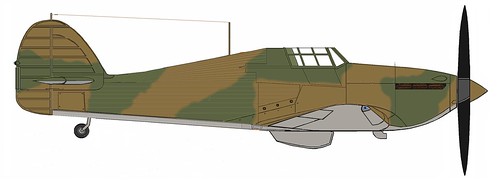Mid-production Hawker Hurricane, Mk I, with de Havilland 2-position propeller. This is what one would look like if it was painted all together, and they stopped before applying the national and service markings. Just “B” pattern camouflage on top, Dark Green and Dark Earth. Starboard side white, port side black, underneath, meeting at the centerline. Nothing of the original “Aluminum” finish remains outside, but the wheel wells and inside of the undercarriage doors might well be “Aluminum”, still. Black spinner.
The “A” and “B” camouflage patterns were mirror images, so this starboard, “B” scheme, is the same as a port-side “A” scheme, except reversed left to right
The black/white underside recognition features was ordered in August 1938. While the requirement for black under the port wing was made known fairly readily, how to treat the starboard wing, horizontal stabilizers and fuselage underside was somewhat to very unclear between 8/38 and 4/39. The intent was to have the port side black up to the center of the fuselage, and the starboard side white, up to the center of the fuselage, as this drawing and its companion show.
Fixed pitch, variable pitch and constant-speed propellers: De Havilland’s 2-position propeller was hydraulically actuated, the design licensed from Hamilton-Standard. The 2 positions were “Fine” for takeoff, “coarse” for maximum speed. Better than the fixed-pitch, solid wood Watts propeller, but quickly replaced by the British engineered Rotol constant-speed design. A constant-speed propeller changes pitch in response to engine power- open the throttle and the blades bite deeply. Close the throttle and the blades barely nibble. Inertia of the moving pieces has little effect on changes in power, no waiting for the engine itself to speed up or slow down.
Hamilton Standard’s own constant-speed design was the “Hydromatic”. Curtis-Wright backed a constant speed design operated by an electric motor, which had the advantage of being able to “feather”, go to super-coarse pitch, for least drag, whether or not the engine was running. Hydraulic operation required the engine-driven hydraulic pump to change pitch, so feathering had to be done *while* shutting down a failing engine.


